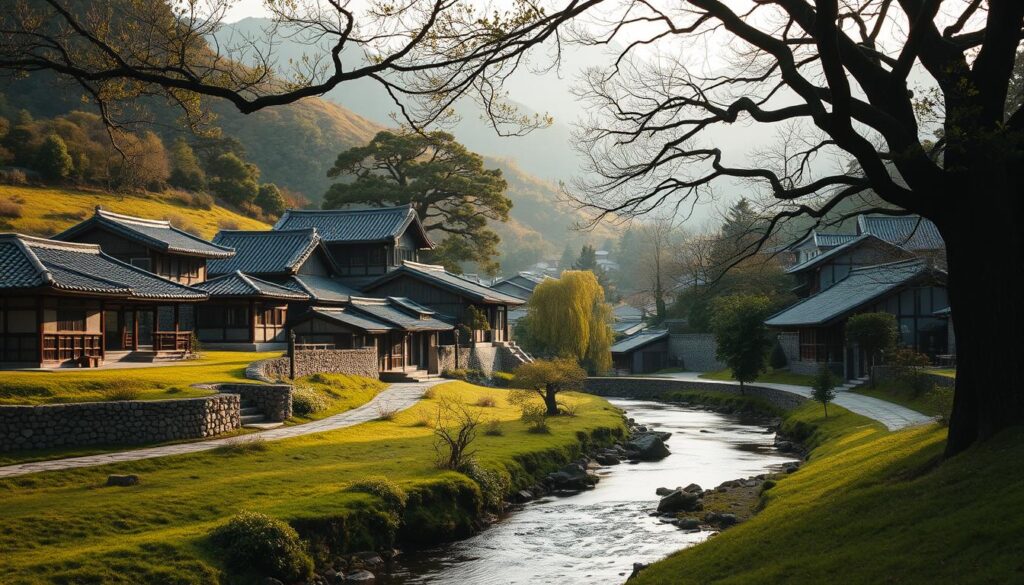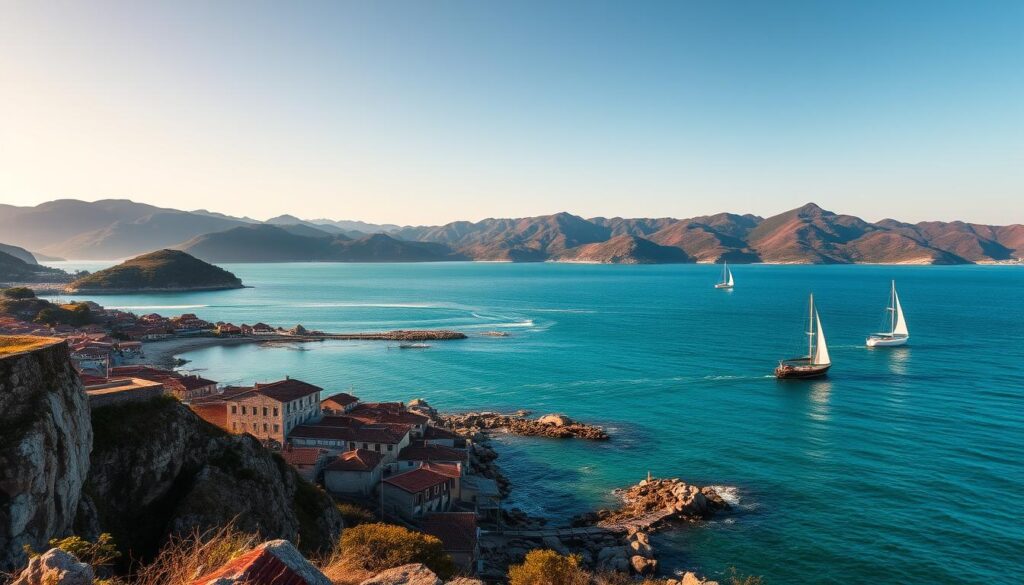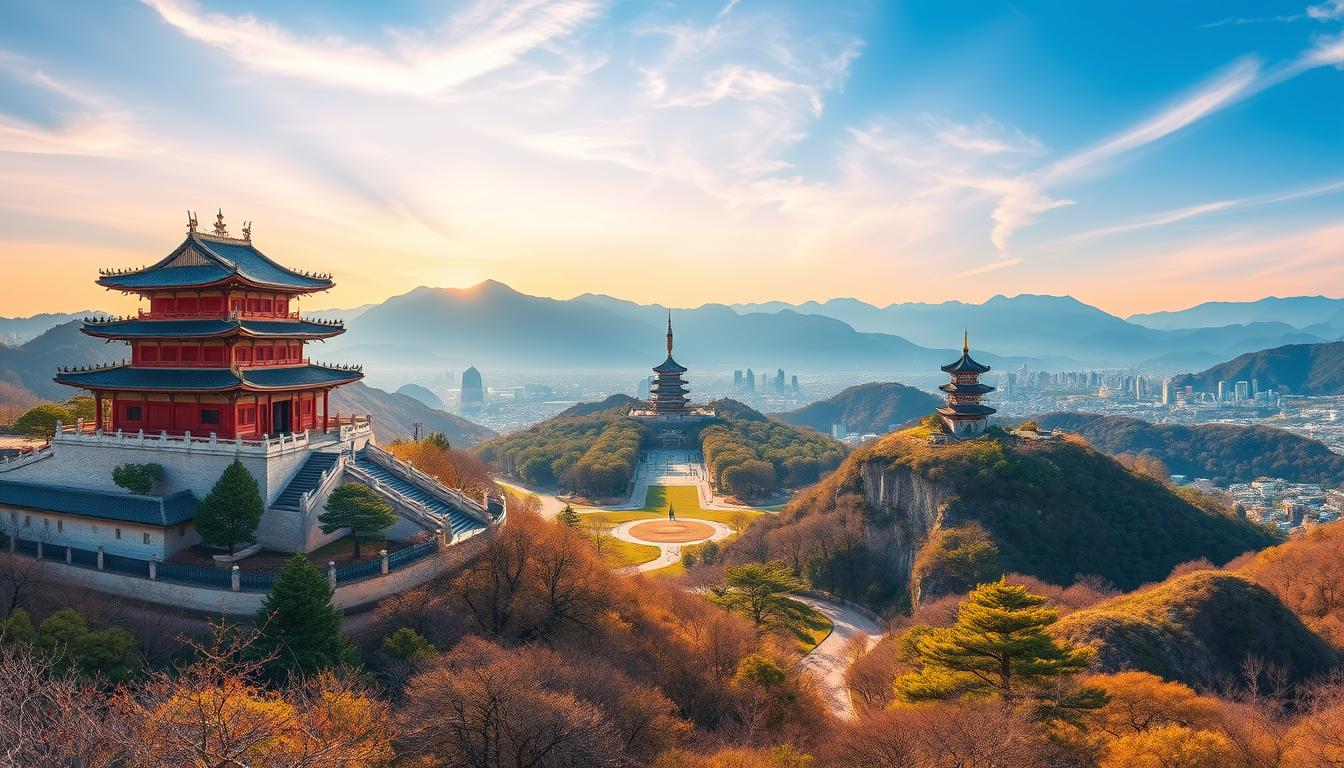Korea Sightseeing Places: Discover the Best Views and Landmarks in South Korea
Table of Contents
When I first arrived in South Korea, I was amazed by its mix of old traditions and new tech. Right from the start, you’ll see why these spots draw visitors from everywhere.
South Korea has so much to offer that it will change how you think about travel. You’ll find everything from Seoul’s busy streets to hidden cultural spots. These places promise memories you’ll never forget.
Exploring South Korea, you’ll see a country that values its history and loves new tech. With over 600 train stations, the Korea Rail Pass makes it easy to see the best spots. You’ll see ancient palaces and stunning natural views.
Imagine being 500 meters above Seoul at N Seoul Tower, seeing the city’s lively vibe. Or visit Gyeongbokgung Palace, built in 1395, to learn about the Joseon dynasty. Each place gives you a special look into Korea’s culture.
Get ready for an adventure that will make you see things differently. South Korea is waiting to take you on unforgettable journeys that will stay with you forever.
Exploring Seoul’s Iconic Landmarks
Seoul is a vibrant city in Korea, full of history and modern sights. As you explore, you’ll see how old traditions meet new architecture. It’s a city that never stops changing.
Gyeongbokgung Palace: A Royal Heritage Site
Gyeongbokgung Palace shows Korea’s deep cultural roots. Built in 1395, it’s a marvel of Korean design. You’ll see:
- Intricate wooden structures with vibrant colors
- Expansive royal grounds covering 410,000 square meters
- Daily Royal Guard Changing Ceremony
N Seoul Tower: Panoramic City Views
N Seoul Tower sits 236 meters high, giving you amazing views. This landmark is a must-see for:
- 360-degree views of Seoul’s stunning cityscape
- Multiple observation decks
- Romantic love-lock fence
Changdeokgung Palace and Secret Garden
Changdeokgung Palace is a UNESCO World Heritage Site. The Secret Garden is a peaceful place with:
- Traditional Korean landscaping
- Ancient trees and peaceful ponds
- Meticulously preserved historical spaces
| Landmark | Operating Hours | Admission Fees |
|---|---|---|
| Gyeongbokgung Palace | 9 AM – 6 PM | Adults: 119 PHP |
| N Seoul Tower | 10 AM – 11 PM | Starting at 645 PHP |
| Changdeokgung Palace | 9 AM – 6 PM | Adults: Varies |
Historical Temples and Religious Sites
Discover the spiritual heart of Korea through its stunning historical temples and religious landmarks. South Korea invites you on a deep journey into Buddhist culture and ancient architecture. It will capture your imagination.
Buddhist temples are among the most famous sights in Korea. They are remarkable historical landmarks. Each temple has its own story of spiritual devotion and cultural heritage.
- Bulguksa Temple: A UNESCO World Heritage site in Gyeongju
- Haeinsa Temple: Home to the world’s oldest intact Buddhist canon
- Tongdosa Temple: One of the “Three Jewel Temples of Korea”
Beomeosa Temple gives a fascinating look into Korean Buddhist traditions. It was founded in 678 during the Silla Dynasty. It’s the third-largest temple in the Yeongnam area and a major center of the Jogye Order of Buddhism.
| Temple | Unique Feature | Historical Significance |
|---|---|---|
| Haedong Yonggungsa Temple | Coastal Buddhist center | One of only two Buddhist centers on the Korean coastline |
| Beomeosa Temple | Meditation programs | Offers Templestay experiences with 10-hour daily meditation sessions |
The Templestay programme is perfect for those wanting a deep cultural experience. It lets you explore monastic life. You can join meditation sessions, learn traditional practices, and understand Korean spiritual traditions.
If you’re interested in Korea’s history or seeking spiritual growth, these temples are a must-see. They offer a memorable journey through South Korea’s rich culture.
Korea Sightseeing Places: Natural Wonders and Parks
South Korea is home to many scenic spots that show off its stunning natural beauty. You can see everything from rugged mountains to volcanic islands. These places offer travelers amazing experiences in nature.
Exploring Korea’s natural wonders will take you through diverse ecosystems and geographical marvels. These spots are perfect for outdoor lovers.
Seoraksan National Park Adventures
Seoraksan National Park is in the northeastern part of South Korea. It’s a top spot for nature fans. The park is 1,708 meters high and welcomes over 5 million visitors every year.
- Hiking trails for all skill levels
- Spectacular autumn foliage showing off red, orange, and green colors
- UNESCO-designated biosphere reserve
- Diverse wildlife and endemic plant species
Jeju Island’s Volcanic Landscapes
Jeju Island is about 450 km from Seoul and is a volcanic wonderland. It has amazing natural formations that will amaze you.
- 26 surrounding islets
- 60 unique lava caves
- Manjanggul Lava Tube stretching 13,400 meters
- Seongsan Ilchulbong Peak, a UNESCO World Heritage site
Dadohaehaesang National Park Exploration
Dadohaehaesang National Park is Korea’s largest national park. It covers over 1,700 islands, giving you a unique marine ecosystem experience. You’ll see untouched coastal landscapes and incredible biodiversity.
- Vast archipelago with numerous islands
- Rich marine wildlife
- Opportunities for island hopping
- Unique coastal conservation areas
Each of these natural spots offers a special look at Korea’s stunning geography. They promise adventure and breathtaking views for every traveler.
Traditional Villages and Cultural Heritage

Exploring Korea reveals a world of traditional villages. These places give a peek into the country’s rich culture. They show how Korean society has been shaped over centuries.
Historic villages are among Korea’s top travel spots. Bukchon Hanok Village in Seoul is a standout. It has over 800 traditional Korean homes that take visitors back in time.
- Bukchon Hanok Village: Located between royal palaces
- Andong Hahoe Folk Village: UNESCO World Heritage site
- Gyeongju Historic Areas: Ancient Silla Kingdom heritage
The Hahoe Folk Village is a unique spot for experiencing Korean culture. It’s a UNESCO site known for its mask dance drama and old architecture from the 14th and 15th centuries.
| Village | Unique Feature | Historical Significance |
|---|---|---|
| Bukchon Hanok Village | Traditional Korean Houses | Preserved Urban Architectural Heritage |
| Andong Hahoe Village | Mask Dance Traditions | UNESCO World Heritage Site |
| Gyeongju Historic Areas | Silla Kingdom Artifacts | Ancient Cultural Center |
Visitors can dive into traditional Korean life. They can try ancient crafts like embroidery, pottery, and tea ceremonies. These activities connect you to Korea’s cultural roots and offer a special view of its heritage.
Modern Architectural Marvels
South Korea’s modern architecture is a sight to behold. It turns cities into top attractions in Korea. These places mix cutting-edge tech with stunning design.
Lotte World Tower Observation Deck
The Lotte World Tower stands tall at 555 meters in Seoul. It offers a sky-high view from its observation deck. You’ll see the city from above, making it a top attraction in Korea.
- Height: 555 meters
- Total floors: 123
- Ranking: 5th tallest building worldwide
Dongdaemun Design Plaza
Zaha Hadid designed the Dongdaemun Design Plaza (DDP). It’s a futuristic spot in Seoul. Over 4 million people visit each year, drawn by its unique design and cultural shows.
| Feature | Details |
|---|---|
| Annual Visitors | 4 million |
| Shopping Spaces | 25 shopping malls |
| Specialty Stores | 3,000 |
Incheon International Airport Complex
Incheon International Airport is a top airport globally. Its design shows South Korea’s tech skills and commitment to quality. It’s a peek into Korea’s modern architecture.
Coastal Attractions and Beach Destinations

South Korea has amazing coastal spots that are truly stunning. You can find everything from beautiful beaches to lively seaside towns. The country’s coastline is full of natural wonders and fun activities.
Exploring Korea’s coast is a special experience. It combines natural beauty with cultural fun. Beaches here offer relaxation or exciting water sports for everyone.
- Haeundae Beach in Busan: Urban beach paradise with numerous cultural events
- Hyeopjae Beach on Jeju Island: Crystal-clear waters and white sandy shores
- Sokcho Beach: Stunning mountain backdrop and excellent water activities
Korean beaches are open from June to August, making summer lively for visitors. Each beach has its own special charm:
| Beach Location | Unique Feature | Best Time to Visit |
|---|---|---|
| Haeundae Beach | Annual film festival and sand sculpture events | July-August |
| Hyeopjae Beach | Shallow, safe swimming conditions | June-September |
| Sokcho Beach | Mountain views and water sports | July-August |
For extraordinary experiences, some beaches are unique. Muchangpo Beach is famous for its “Moses Miracle,” where tides create a path. The Boryeong Mud Festival is a fun event for those looking for a coastal adventure.
Korea’s coast has something for everyone. Whether you want to relax, try water sports, or enjoy cultural events, you’ll make unforgettable memories.
Urban Entertainment Districts
Seoul is alive with energy, making it a top spot for travelers. These areas show off South Korea’s modern culture. They offer experiences that visitors won’t forget.
Myeongdong Shopping Street
Myeongdong is a shopper’s dream, drawing in millions every year. It’s a place where:
- International and local fashion brands
- Korean cosmetic stores
- Street food vendors
- Electronics shops
It’s a world of trendy boutiques and traditional Korean shops. The area is full of life, perfect for those who love fashion and food.
Hongdae Arts and Culture Scene
Hongdae is near Hongik University and is full of creativity. Street performers, indie musicians, and artists make it a vibrant place. You can see:
- Unique art galleries
- Underground music venues
- Quirky cafes
- Vintage clothing stores
Hongdae shows the creative side of Korean youth. It’s a real look at modern Korean culture.
Gangnam District Highlights
Gangnam is known for its luxury and style, thanks to a famous song. This area has:
- High-end shopping centers
- Trendy restaurants
- Premium entertainment venues
- Modern art galleries
Visiting Gangnam lets you see Seoul’s most glamorous side. It’s where style and innovation meet.
Mountain Trails and Hiking Spots
South Korea is a paradise for hikers, with 22 national parks and stunning mountain trails. You’ll find everything from tough mountain peaks to easy forest paths. It’s a dream come true for outdoor lovers.
- Bukhansan National Park: Near Seoul, it has many trails with amazing city views
- Hallasan Mountain: The highest peak in South Korea, on Jeju Island, at 1,950 meters
- Seoraksan National Park: Home to Daechongbong Peak at 1,708 meters, with breathtaking views
Hiking each trail offers its own unique challenges and rewards. Hallasan Mountain, a UNESCO World Natural Heritage Site, has diverse ecosystems and stunning views. The Baengnokdam Crater, formed 20,000 years ago, is a geological wonder.
For the serious hiker, trails like the Daechongbong Trail in Seoraksan National Park are a tough but rewarding climb. With elevation gains from 4,700 feet to summit routes, you’ll see Korea’s beauty up close.
Pro tip: Always check trail conditions, bring the right gear, and follow local hiking rules.
Whether you’re new to hiking or have lots of experience, Korea’s trails offer unforgettable adventures. You’ll see diverse and stunning landscapes.
UNESCO World Heritage Sites
South Korea has 14 UNESCO World Heritage Sites. These sites show the country’s rich culture and history. They are among the top attractions in Korea, taking you on a journey through time.
The UNESCO sites cover different periods and cultures. You’ll see ancient temples and fortifications. Each site shares a unique part of Korean history, showing architectural skill, spiritual depth, and resilience.
Exploring these sites, you’ll see amazing preservation and cultural importance. They protect physical structures and traditions that shape Korean identity. Places like Haeinsa Temple and Joseon Dynasty tombs offer a deep dive into Korea’s culture.
For history lovers or cultural explorers, these UNESCO sites are a must-see. They are more than tourist spots. They are living reminders of Korea’s rich heritage, inspiring and educating visitors.
FAQ
What are the best times to visit South Korea for sightseeing?
Do I need a visa to travel to South Korea?
What is the best way to get around South Korea?
Is English widely spoken in tourist areas?
What are the must-try Korean foods for tourists?
How safe is South Korea for tourists?
What should I know about Korean cultural etiquette?
What is the currency in South Korea, and how can I manage my money?
What are the best souvenirs to bring back from South Korea?
How expensive is traveling in South Korea?
Source Links
- 14 Days in South Korea: Must-See Attractions and Best Things to Do – Klook Travel Blog – https://www.klook.com/blog/must-see-attractions-south-korea/
- Top 10 Tourist Attractions in South Korea: Festivals & Fun! » Agoda: See The World For Less – https://www.agoda.com/travel-guides/south-korea/top-10-tourist-attractions-in-south-korea-festivals-fun/
- 19 Top-Rated Tourist Attractions in South Korea – https://www.planetware.com/south-korea/top-rated-tourist-attractions-in-south-korea-kor-1-4.htm
- Korean Landmarks: 9 Iconic Sites You Can’t Miss – https://landmarksarchitects.com/korean-landmarks/
- Iconic Sights of Seoul – TEAN – https://teanabroad.org/blog/iconic-sights-of-seoul/
- Top 19 Seoul Tourist Spots That You Shouldn’t Miss – https://www.traveloka.com/en-ph/explore/destination/seoul-tourist-spots/63960
- Take a journey to Busan’s sacred temples to uncover South Korea’s spiritual side – https://www.nationalgeographic.com/travel/article/paid-content-take-a-journey-to-busans-sacred-temples-to-uncover-south-koreas-spiritual-side
- Historical & Cultural Immersion Tour of South Korea with Temple Stay: Seoul, Gyeongju & Busan – 7 Days – https://www.kimkim.com/c/historical-cultural-immersion-tour-south-korea-temple-stay-7-days
- World’s Top 9 Most Important Holy Places and Religious Sites – https://www.trip.com/blog/worlds-holy-places-and-religious-sites/
- 8 Best Natural Attractions in South Korea – https://www.odynovotours.com/south-korea/best-natural-attractions.html
- Nature Detour: 9 Stunning Natural Attractions to Visit in South Korea – https://www.tripzilla.com/south-korea-natural-attractions/41118
- 10 Best National Parks In Korea To Visit For Beautiful Views – https://inmykorea.com/best-national-parks-in-korea/
- List of World Heritage Sites in South Korea – https://en.wikipedia.org/wiki/List_of_World_Heritage_Sites_in_South_Korea
- Best Hanok Villages: A Traveler’s Guide to South Korea Homes – https://www.cooltourismical.com/best-ancient-hanok-villages-south-korea.html
- Cultural Heritage Sites : VISITKOREA – https://english.visitkorea.or.kr/svc/contents/contentsView.do?vcontsId=172555
- Air Canada Vacations | Making your dreams travel™ – https://vacations.aircanada.com/en/tour-details/ICNBSK/the-best-of-south-korea
- Seoul Unveiled: A Whirlwind Tour Through Neighborhoods, Art, and Culture – https://sana.social/travel-with-me/seoul-unveiled-a-whirlwind-tour-through-neighborhoods-art-and-culture/
- 40 Places to Visit in Seoul, Tourist Places & Top Attractions – https://www.thrillophilia.com/destinations/seoul/places-to-visit
- Korea Information – Tourism — Korean Cultural Center New York – https://www.koreanculture.org/korea-information-tourism
- Summer seaside fun: Best coastal destinations in Korea – https://korea.stripes.com/travel/summer-seaside-fun-best-coastal-destinations-in-korea.html
- Best places to visit in South Korea – https://www.lonelyplanet.com/articles/best-places-to-visit-in-south-korea
- Top 28 Places In South Korea In 2025 That Bring Out The Vibrant Charm Of The Exotic Nation – https://traveltriangle.com/blog/places-to-visit-in-south-korea/
- What to See in South Korea: Best Attractions to Visit – https://www.odynovotours.com/south-korea/best-attractions-to-visit.html
- The Ultimate List for the Best South Korea Hiking – https://globetrotterkyle.com/south-korea-hiking/
- Top 10 Hikes and Walks in South Korea | Komoot – https://www.komoot.com/guide/72230/hiking-in-south-korea
- Reach New Heights with Korea’s National Parks! Best Hiking Trails in Korea : VISITKOREA – https://english.visitkorea.or.kr/svc/contents/contentsView.do?vcontsId=204732
- World Heritage Sites in South Korea: Complete list in 2025 – https://www.timetravelturtle.com/south-korea/world-heritage-sites-in-south-korea/
- UNESCO World Heritage Tour in South Korea – https://www.regent-holidays.co.uk/tour/unesco-world-heritage-tour-in-south-korea/
- Gyeongju Travel – https://www.gyeongju.go.kr/tour/eng/page.do?mnu_uid=2762&

